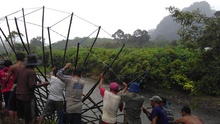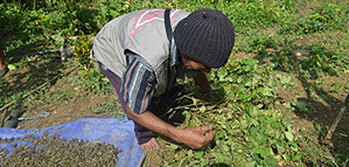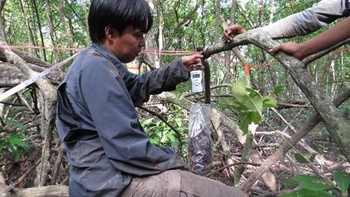Biodiversity and climate change
Project description
Project title: Biodiversity and climate change (BIOCLIME)Commissioned by: German Federal Ministry for the Environment, Nature Conservation, Building and Nuclear Safety (BMUB)
Country: Indonesia
Lead executing agency: Indonesian Ministry of Environment and Forestry
Overall term: 2012 to 2017

Context
One of the planet’s biodiversity hotspots, Indonesia has the third largest area of tropical forest in the world. It is also home to the most extensive peat bogs in the tropics. Progressive deforestation and degradation of forests and moorland, in particular through slash-and-burn activities, are resulting in a rapid decline in biodiversity and are simultaneously contributing significantly to the country’s high level of CO2 emissions.
Loss of biodiversity has a negative impact on the capacity of ecosystems to adapt to climate change. At the same time, an estimated 40 million Indonesians living in rural areas are at risk of losing their livelihoods. In South Sumatra in particular, the remaining forest ecosystems are severely fragmented and threatened by illegal logging, the expansion of mining activities and plantations, and forest fires. The challenge lies in developing strategies geared to the protection and sustainable management of forests with a high conservation value that will enjoy the support of the population, the private sector and the relevant authorities in equal measure.
Objective
Authorities and institutions in South Sumatra are empowered to develop and implement sustainable conservation and management strategies for forests with a high conservation value.

Approach
The project team supports the Indonesian Government in its efforts to achieve the biodiversity and climate change mitigation and adaptation objectives to which the country has committed itself under the terms of the Convention on Biodiversity and the Framework Convention on Climate Change. The project partners are the Indonesian Ministry of Environment and Forestry, the South Sumatra Provincial Forestry Department and the Office of Development Planning.
The focus is on creating a new information base for selecting forestry areas and ecosystems with a particularly high conservation value. The project assists the Ministry and the aforementioned authorities in establishing transparent and participatory planning and decision-making processes. By delivering training and introducing clear organisational procedures, it develops the management capacity of the institutions and authorities, thus empowering them to develop and implement conservation strategies and reduce illegal activities. There is a particular emphasis in this context on local government institutions and village communities. Working with its partners, the project team develops systems for monitoring and steering activities on an ongoing basis. By developing alternative sources of income for the population living in and around protected areas, the project ensures that new conservation strategies will be compatible with the socio-economic structures of the local people.
New systems for data management facilitate land use planning, taking due account of ecosystems with a particularly high conservation value, biodiversity and climate concerns. In addition, the project assists the Indonesian Government in implementing its One Map policy. The aim of this policy is to clarify overlapping land use rights and to bring existing forms of land use into line with official regional planning.
The Indonesian forestry authorities are also receiving support in reorganising their structures. Specifically, this involves setting up new local forestry administrative units, which work with the various interest groups to provide targeted forest ecosystem management that protects biodiversity and takes account of the consequences of climate change.
Results
The project, which has also been running in South Sumatra Province and its regencies since January 2014, has linked the objectives of the Convention on Biodiversity with those of the Framework Convention on Climate Change. The regional and local forestry administrations now incorporate the topic of biodiversity into their forest management plans. The authorities have transferred the biodiversity strategy for South Sumatra into their spatial development plans.

Working with the project, the partners have created databases on biomass, flora and fauna. These databases provide the foundation for climate-friendly and environmentally responsible land use planning processes and for long-term monitoring and reporting. The project team has presented new monitoring instruments and worked with partners to introduce these instruments, primarily on the basis of remote sensing. Today, universities and non-governmental organisations are involved in government administrative work. This is giving rise to reliable, long-term partnerships.